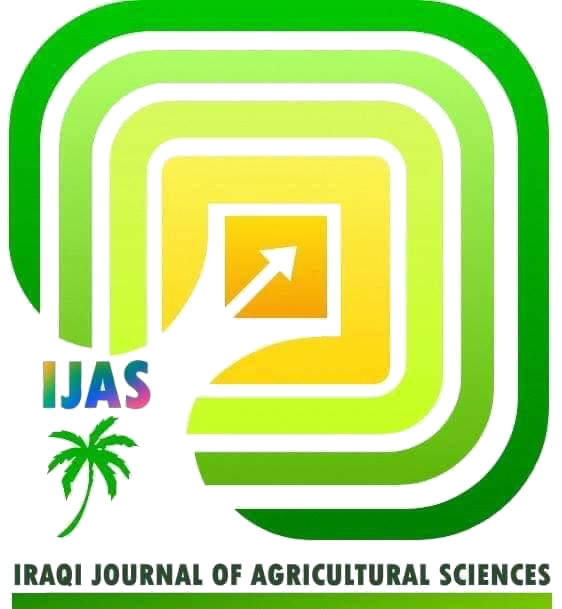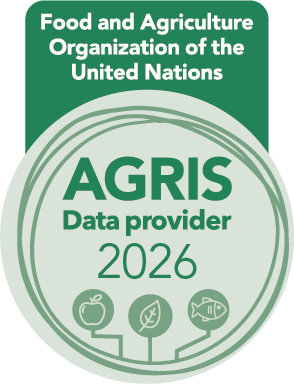EFEFCT OF KAOLIN ON GROWTH AND CLINICAL SIGNS IN COMMON CARP EXPOSED TO COPPER SULPHATE TOXICITY
DOI:
https://doi.org/10.36103/dcc82284Keywords:
fish, heavy metal, pollution, nutritionAbstract
This study was aimed to investigate the effect of kaolin on growth and clinical signs in Cyprinus carpio exposed to copper sulphate. For this rationale, six treatment groups with two replicates were used in this experiment as follows: C- served as control negative group without exposed to kaolin or CuSO4; C+ served as control positive group was exposed to 0.91mg/l CuSO4 only; T1, T2, T3 and T4 were subjected to 0.91mg/l of CuSO4 and kaolin was added to them at levels of 2, 4, 6 and 8 g/l respectively. Result findings reveal a positive relationship of the mean total weight gain among treatments T1, T2, T3 and T4 with the increase in the percentage of kaolin, practically in T4 which reached 13.2g. The mean daily weight gain of the experimental fish ranged between – 0.08 g/day/fish in C+ treatment to 0.55g/day/fish in C- treatment. C- treatment recorded the best value for feed conversion ratio and feed conversion efficiency with values of 3.5 and 28.57% respectively, followed by T4 with values of 3.9 and 25.0% respectively. In addition, values of the relative growth rates fluctuated between the lowest value in C+ treatment (-2.50%) and the highest value in C- treatment (18.34%). Specific growth rate, experienced the same previous pattern as they ranged between – 0.04 and 0.24%/day in C+ and C- treatments respectively. These results suggested that kaolin helped to reduce the toxicity of copper sulphate in experimental fish.
References
1. Abdullahi, T., Z. Harun, and M. H. D. Othman. 2017. A review on sustainable synthesis of zeolite from kaolinite resources via hydrothermal process. Advanced Powder Technology. 28(8): 1827-1840. https://doi.org/10.1016/j.apt.2017.04.028
2. Alengebawy, A., S. T. Abdelkhalek, S. R. Qureshi and M. Q. Wang. 2021. Heavy metals and pesticides toxicity in agricultural soil and slants: Ecological risks and human health implications. Toxics. 9(3). 42. https://doi.org/10.3390/toxics9030042
3. Al-Ghazaly, M. N. and A. J. Al-Rudainy.2024.Effect of kaolin on biochemical parameters against Aeromonas hydrophila in Cyprinus carpio. Iraqi Journal of Agricultural Sciences. 55(4):1353-1359. https://doi.org/10.36103/5tch9p19
4. Al-Tamimi, M.S. and A. J. Al-Rudainy.2024. Effect of kaolin on hematological and biochemical parameters of Cyprinus carpio L. against copper sulphate toxicity. Iraqi Journal of Agricultural Sciences. 55 (Special Issue): 217-224. https://doi.org/10.36103/ijas.v55iSpecial.1900
5. Anandkumar, A., R. Nagarajan, K. Prabakaran and R.Rajaram.2017. Trace metals dynamics and risk assessment in the commercially important marine shrimp species collected from the Miri coast, Sarawak, East Malaysia. Reg. Stud. Mar. Sci.16:79–88. https://doi.org/10.1016/j.rsma.2017.08.007
6. Assefa, A. and F. Abunna. 2018. Maintenance of fish health in aquaculture: review of epidemiological approaches for prevention and control of infectious disease of fish. Veterinary Medicine International. https://doi.org/10.1155/2018/5432497.
7. Awad, M. E., A. López-Galindo, M. Setti, M. M. El-Rahmany, and C. V. Iborra. 2017. Kaolinite in pharmaceutics and biomedicine. International Journal of Pharmaceutics. 533(1): 34-48. https://doi.org/10.1016/j.ijpharm.2017.09.056
8. Badawi, A. and S. Magdy. 2023. Evaluation of the pollution extent of heavy metals in the sediment of the Nile Delta, Mediterranean Coast, Egypt. Egyp. J. Aquac. Res.49(2):221–228. https://doi.org/10.1016/j.ejar.2023.01.002
9. Beck, B. H., L. M. Barnett, B. D. Farmer, E. Peatman and D. Carter.2014. Kaolinitic clay protects against Flavobacterium columnare infection in channel catfish Ictalurus punctatus (Rafinesque).J. Fish Dis. 38(3):1-8. https://doi.org/10.1111/jfd.12229
10. Bhattacharjee, A., K. Chakraborty and A. Shukla. 2017. Cellular copper homeostasis :Current concepts on its interplay with glutathione homeostasis and its implication in physiology and human diseases. Metallomics. 1376-1388. https://doi.org/10.1039/c7mt00066a
11. Binukumari, S., K. Anusiya-Devi and J. Vasanthi. 2017. Applications in environmental risk assessment of biochemical analysis on the Indian freshwater fish,(Labeo rohita) exposed to monocrotophos pesticide. Journal of Environmental Toxicology and Pharmacology.47: 200- 205. http://dx.doi.org/doi:10.1016/j.etap.2016.08.014
12. Caponi, N., G.C. Collazzo, S.L. Jahn, G.L. Dotto, M.A. Mazutti and E.L. Foletto. 2017. Use of brazilian kaolin as a potential low-cost adsorbent for the removal of malachite green from colored effluents. Mat. Res. 20:14-22. https://doi.org/10.1590/1980-5373-MR-2016-0673
13. Carretero, M. I. and M. Pozo. 2010. Clay and non-clay minerals in the pharmaceutical and cosmetic industries Part II. Active ingredients. Applied Clay Science. 47(3-4): 171-181. https://doi.org/10.1016/j.clay.2009.10.016
14. Dethloff, G.M., H.C. Bailey and K.L. Maier. 2001. Effects of dissolved copper on select haematological, biochemical and immunological parameters of wild rainbow trout, Oncorhynchus mykiss. Environ. Contam. Toxicol. 40:371-80. https://doi.org/10.1007/s002440010185
15. Edeh, E. C.2019. Acute Toxicity of Copper and Zinc and their Lethal Concentration on Clarias gariepinus (Cat Fish). Zhejiang Normal University, China. https://doi.org/10.26717/BJSTR.2019.17.003076
16. Eissa,I.A.M., H.I.Derwa, M. M. Ismail, M.M.M. El-Lamie and T.M. Elsayed.2015. Use of kaolin for protection against Flavobacteriosis in Oreochromis niloticus SCVMJ.XX (1): 2015 307-314. http://dx.doi.org/10.21608/scvmj.2015.65066
17. Elahe, E., E. Elnaz and N. Kasalkhe. 2018. Acute toxicity and the effects of copper sulphate [CuSo4.5H2O] on the behavior of the gray mullet [Mugil cephalus]. Int. J. Sci. Res. Environ. Sci. Toxicol.3(2):1-4. http://dx.doi.org/10.15226/2572-3162/3/2/00119
18. Govind, P. and S. Madhuri. 2014. Heavy metals causing toxicity in animals and fishes. Res. J. Anim. Vet. Fishery Sci. 2(2):17–23. https://www.researchgate.net/publication/303213699
19. Hama Aziz, K. H. and F. S. Mustafa. 2024. Advanced oxidation processes for the decontamination of heavy metal complexes in aquatic systems: A review. Case Stud. Chem. Environ. Eng. 9: 100567. https://doi.org/10.1016/j.cscee.2023.100567
20. Hama Aziz, K. H., F. S. Mustafa, K. M. Omer, S. Hama, R. F. Hamarawf and K. O. Rahman. 2023. Heavy metal pollution in the aquatic environment: Efficient and low-cost removal approaches to eliminate their toxicity: A review. RSC Advances.13(26): 17595–17610. https://doi.org/10.1039/D3RA00723E
21. Harikrishnan, R. 2016. Dietary supplementation of zeolite on growth performance, immunological role, and disease resistance in Channa striatus against Aphanomyces invadans, Fish Shellfish Immunol. 51: 161–169. https://doi.org/10.1016/j.fsi.2016.02.019-
22. Harikrishnan, R., S. Jawahar, C. Srikanthan, C., B. A. Paray, M.K. Al-Sadoon and C. Balasundaram. 2018. Effect of a kaolin-incorporated diet on growth and immune response in Ctenopharyngodon idella against Aeromonas hydrophila. Fish Shellfish Immunol. 77: 364-373. https://doi.org/10.1016/j.fsi.2018.04.015
23. Hertika, A. M. S., K. Kusriani, E. Indrayani and R. B. D. S. Putra.2021. Density and intensity of metallothionein of Crassostrea sp. as biomarkers of heavy metal contamination in the Northern coast of East Java, Indonesia. Egyp. J. Aquac. Res. 47(2):109–116. https://doi.org/10.1016/j.ejar.2021.04.006
24. Jawahar, S., A. Nafar, K. Vasanth, M.S.Musthafa, J. Arockiaraj, C. Balasundaram and R. Harikrishnan. 2016. Dietary supplementation of zeolite on growth performance, immunological role, and disease resistance in Channa striatus against Aphanomyces invadans, Fish Shellfish Immunol. 51: 161–169. https://doi.org/10.1016/j.fsi.2016.02.019
25. Kim, H.,T.Phenrat, R. D. Tilton and G. V. Lowry.2012.Effect of kaolinite, silica fines and pH on transport of polymer-modified zero valent iron nano-particles in heterogeneous porous media. Journal of Colloid and Interface Science.370(1):1-10. https://doi.org/10.1016/j.jcis.2011.12.059
26. Linder,M.C.2020.Copper homeostasis in mammals ,with emphasis on secretion and excretion . A review. International Journal of Molecular Sciences.21(14):2-22. http://dx.doi.org/10.3390/ijms21144932
27. Marcos T. 2021.Toxic, physiological, histomorphological, growth performance and antiparasitic effects of copper sulphate in fish aquaculture. Aquaculture.Volume 535, 30. https://doi.org/10.1016/j.aquaculture.2021.736350
28. Mueller ,B. 2015. Experimental interactions between clay minerals and bacteria: A review. Pedosphere. 25:799-810. https://doi.org/10.1016/S1002-0160(15)30061-8
29. Murray, H.H. 2000. Traditional and new applications for kaolin, smectite, and palygorskite: a general overview. Appl. Clay Sci. 17: 207–221. https://doi.org/10.1016/S0169-1317(00)00016-8
30. Mustafa, S. A. 2020. Histopathology and heavy metal bioaccumulation in some tissues of Luciobarbus xanthopterus collected from Tigris River of Baghdad, Iraq. Egyp. J. Aqua. Res. 46:123–129. https://doi.org/10.1016/j.ejar.2020.01.004
31. Mustafa, S.A. S.J. Davies and A.N. Jha. 2012. Determination of hypoxia and dietary copper mediated sub-lethal toxicity in carp, Cyprinus carpio, at different levels of biological organization. Chemosphere.4:413-422. https://doi.org/10.1016/j.chemosphere.2011.12.037
32. Mustafa, S.A., A. J. Al-Rudainy and N.M. Salman.2024. Effect of environmental pollutants on fish health: An overview. The Egyptian of Aquatic Research.50 : 225–233. https://doi.org/10.1016/j.ejar.2024.02.006
33. Mustapha, S., M. M. Ndamitso, A.S. Abdulkareem, J.O. Tijani, A.K. Mohammed and D.T. Shuaib.2019.Potential of using kaolin as a natural adsorbent for the removal of pollutants from tannery wastewater. Heliyon. 5(11). https://doi.org/10.1016/j.heliyon.2019.e02923
34. Ramos-Misra, J. , M. Sanches-muros, M. Morote, E. Torrijos, C. Gill, R. Zamani-Ahmadmahmoodi and J. R. Martin. 2019. Potentially toxic elements in commonly consumed fish species from the western Mediterranean Sea (Almeria Bay): Bioaccumulation in liver and muscle tissues in relation to biometric parameters. Sciences of the Total Environment. 671: 280-287. https://doi.org/10.1016/j.scitotenv.2019.03.359
35. Tessema, A., A. Getahun, S. Mengistou, T. Fetahi and E. Dejen.2020.Reproductive biology of common carp (Cyprinus carpio L.) in lake Hayq, Ethiopia. Fisheries and Aquatic Sciences.23(16):2-10. https://doi.org/10.1186/s41240-020-00162-x
36. Uncumusaoğlu, A. A. 2018. Blood biochemical changes in common carp (Cyprinus carpio Linnaeus,1758) fed different levels of copper sulphate and zeolite. Turkish Journal of Agriculture - Food Science and Technology.6(1):1-6. https://doi.org/10.24925/turjaf.v6i1.01-06.1651
37. Vali, S., N. Majidiyan,, A.M. Yalsuyi, M. F. Vajargah, M. D Proki´c and C. Faggio. 2022. Ecotoxicological effects of silver nanoparticles (Ag-NPs) on parturition time, survival rate, reproductive success and blood parameters of adult common molly (Poecilia sphenops) and their larvae. Water. 14, 144. http://dx.doi.org/10.3390/w14020144
38. Yang, J.L. and H.C. Chen. 2003. Effects of gallium on common carp (Cyprinus carpio): acute test, serum biochemistry, and erythrocyte morphology, Chemosphere. 53(8):877-882.
https://doi.org/10.1016/S0045-6535(03)00657-X
39. Yonar, M. E., U. Ispir, S. M. Yonar and M. Kirici. 2016. Effect of copper sulphate on the antioxidant parameters in the rainbow trout fry, Oncorhynchus mykiss. Cellular and Molecular Biology. 62: 55-58. https://doi.org/10.14715/cmb/2016.62.6.10
40. Zarei, A. P., H. Alipour and S. H. Khazaei.2013. Acute toxicity and the effects of copper sulphate (CuSO4.5H2O) on the behavior of the black fish (Capoeta fusca), Iran. J.Toxicol.6 (19):771-778. http://dx.doi.org/10.3390/w14020144
Downloads
Published
Issue
Section
License
Copyright (c) 2025 IRAQI JOURNAL OF AGRICULTURAL SCIENCES

This work is licensed under a Creative Commons Attribution-NonCommercial 4.0 International License.

2.jpg)


